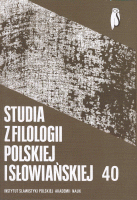Mistrz Polikarp w krajach słowiańskich
Master Polikarp in Slavic countries
Author(s): Ewa SiatkowskaSubject(s): Language studies
Published by: Instytut Slawistyki Polskiej Akademii Nauk
Summary/Abstract: The motif of a conversation with Death, appearing as a human being, was already known in antiquity. A large number of works on this theme appeared in Europe between XII and XVI centuries. Latin originals were often translated into Slavic languages. The interlocutor of Death was often called Polikarp, what could be the name of the original author. The preserved copies of Latin manuscripts state he came from Ireland. Glagolitic Croatian text, preserved in two copies from XV century, is connected with the oldest Latin manuscripts, “the first editing”. The translator is faithful to the Latin original almost completely. The Polish version, with Latin title De morte prologus, has more common features with “second editing” group of manuscripts, that are somewhat younger. The text in Church-Slavonic Russian from XVI century is thought to be a translation of Polish version, but it is closer to travesty, as following differences suggest: the Polish version being rhymed, and Russian in prose, calling Polikarp in the former master, and in the latter philosopher, the place from where Death comes in Polish is szkoła, in Russian: carstwo etc. There is a possibility of texts translated from German Dvojeslovija/prenija života i smerti influencing the abovementioned versions. The German original, through Russian diplomats, came to Novgorod from Lubeck. Even less connected with De morte prologus is – widely considered to be a translation from Polish – XVII century Ukrainian work Slovo o ljutoj smerti... Possibly it is an independent travesty of western Latin themes, that made their way to Ukraine. Czech versions – Rozmlauvání člověka se smrtí from XVIth century and its later version, Hádání člověka se smrtí in turn, are closer to the Polish dialogue, although they are not connected by the name of the protagonist (like Russian and Croatian versions are). Despite thematic similarity they certainly come from different Latin originals, and what is more, they have a sense of a much different local atmosphere.
Journal: Studia z Filologii Polskiej i Słowiańskiej
- Issue Year: 2005
- Issue No: 40
- Page Range: 421-438
- Page Count: 17
- Language: Polish

